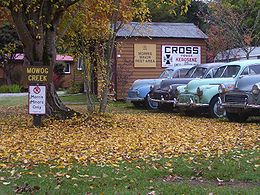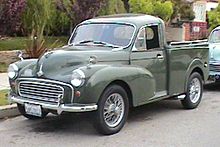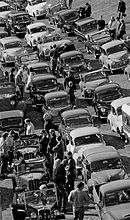- Morris Minor
-
This article refers to the motor car manufactured by the Morris Motor Company and its successors from 1948 to 1971. For the Morris Minor manufactured by the Morris Motor Company from 1928 to 1933, see Morris Minor (1928); for the 1980s pop band, see Morris Minor and the Majors.
Morris Minor 
Manufacturer Morris Production 1948–71; 1,368,291 produced Predecessor Morris Eight Successor Morris 1100, Morris Marina Class Compact Layout FR layout Wheelbase 86 in (2,184 mm) [1] Length 148 in (3,759 mm) Width 60 in (1,524 mm) Height 60 in (1,524 mm) Curb weight 1,708 lb (775 kg) (4 door saloon) Designer Sir Alec Issigonis The Morris Minor was a British economy car that debuted at the Earls Court Motor Show, London, on 20 September 1948.[2] Designed under the leadership of Alec Issigonis, more than 1.3 million were manufactured between 1948 and 1971. Initially available as a 2-door saloon and tourer (convertible), the range was subsequently expanded to include a 4-door saloon in 1950, and in 1952 a wood-framed estate (the Traveller), panel van and pick-up truck variants.
The Minor was manufactured in three series, Series I, Series II (1952) and finally the 1000 series (1956).
Contents
History
Sir Alec Issigonis' concept was to combine the luxury and convenience of a good motor car at a price affordable by the working classes. The Minor was a roomy vehicle with superior cornering and handling characteristics. Internal politics inside BMC, the parent of Morris, may have led to the limited North American sales. The Minor prototype had been known as the Morris Mosquito.[3]
More than 1.3 million of the lightweight, rear-wheel drive cars were eventually produced, mainly in Cowley, Oxfordshire, becoming Britain's first million seller[4], and exported around the world, with many variants of the original model. Production continued in Birmingham, England until 1971 (for the commercial variants and estate only). The last Morris Minor (commercial) was assembled at Stoke, Nelson, New Zealand in 1974.
The Minor has been described as typifying “Englishness”,[5][6][7][8][9] a "British icon" and a "design classic".[10]
Minor MM
Morris Minor MM Production 1948–53; 250,962 produced Assembly Oxford, England Body style 4-door saloon, 2-door coupe, 2-door convertible Engine 918 cc (0.918 l) Morris Sidevalve engine I428hp The original Minor MM series lasted from 1948 until 1953. It included a pair of 4-seat saloons, 2-door and 4-door, and a convertible 4-seat Tourer. The front torsion bar suspension was shared with the larger Morris Oxford, as was the almost-unibody construction. Although the Minor was originally designed to accept a flat-4 engine, with four distinctive gaps in the engine bay to accommodate it, late in the development stage it was replaced by a 918 cc (56.0 cu in) side-valve straight-4 producing 27.5 hp (21 kW) and 39 lbf·ft (53 N·m) of torque. This little engine pushed the Minor to just 64 mph (103 km/h) but delivered 40 miles per imperial gallon (7.1 L/100 km; 33 mpg-US).
Early cars had a painted section in the centre of the bumpers to cover the widening of the production car from the prototypes. This widening of 4 inches (102 mm) is also visible in the creases in the bonnet. Exports to the United States began in 1949 with the headlamps removed from within the grille to be mounted higher on the wings to meet safety regulations. These became standard on all Minors for 1951. From 1948 to 1961, the Minor had semaphore type turn indicators[11]. When production of the first series ended, just over a quarter of a million had been sold, 30% of them the convertible Tourer model.
A tourer tested by the British magazine The Motor in 1950 had a top speed of 58.7 mph (94.5 km/h) and could accelerate from 0–50 mph (80 km/h) in 29.2 seconds for the 1098cc engine. However, the 918cc(56.01CID) engine did 0-60mph in 50+ seconds[12]. A fuel consumption of 42 miles per imperial gallon (6.7 L/100 km; 35 mpg-US) was recorded. The test car cost £382 including taxes.[13]
Minor Series II
Morris Minor Series II 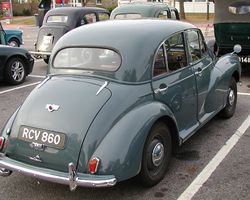
Production 1952–56; 269,838 produced Assembly Oxford, England, Birmingham, England Body style 2-door coupe, 4-door saloon, 2-door convertible, 2-door estate, 2-door pickup truck, 2-door van Engine 803 cc (0.803 l) A-Series I4 In 1952, the Minor line was updated with an Austin-designed 803 cc (49.0 cu in) overhead valve A-Series engine, replacing the original side-valve unit. The engine had been designed for the Minor's main competition, the Austin A30, but became available as Austin and Morris were merged into the British Motor Corporation. The new engine felt stronger, though all measurements were smaller than the old. The 52 second drive to 60 mph (97 km/h) was still calm, with 63 mph (101 km/h) as the top speed. Fuel consumption also rose to 36 miles per imperial gallon (7.8 L/100 km; 30 mpg-US).
An estate version was introduced, known as the Traveller (a Morris naming tradition for estates, also seen on the Mini), along with van and pick-up versions. The Traveller featured an external structural ash (wood) frame for the rear bodywork, with two side-hinged rear doors. The frame was varnished rather than painted and a highly visible feature of the body style. Rear bodies of the van versions were all steel. The 4-seat convertible and saloon variants continued as well.
The grille was modified in October 1954, and a new dashboard with a central speedometer was fitted. Almost half a million examples had been produced when the line ended in 1956.
The Motor magazine tested a 4-door saloon in 1952. It reported a top speed of 62 mph (100 km/h) and acceleration from 0–50 mph (80 km/h) in 28.6 seconds. A fuel consumption of 39.3 miles per imperial gallon (7.19 L/100 km; 32.7 mpg-US) was recorded. The test car cost £631 including taxes.[14]
Engines:
- 1952–56: 803 cc A-Series Straight-4, 30 hp (22 kW) at 4800 rpm and 40 lbf·ft (54 N·m) at 2400 rpm
Minor 1000
Morris Minor 1000 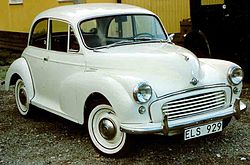
Production 1956–71; 847,491 produced Assembly Oxford, England
Birmingham, EnglandBody style 2-door saloon, 4-door saloon, 2-door convertible, 2-door estate, 2-door pickup truck, 2-door van Engine 948 cc (0.948 l) BMC A-Series I4, 1,098 cc (1.098 l) BMC A-Series I4 The car was again updated in 1956 when the engine was increased in capacity to 948 cc (57.9 cu in). The two-piece split windscreen was replaced with a curved one-piece one and the rear window was enlarged. In 1961 the semaphore-style trafficators were replaced by the flashing direction indicators, then becoming the norm for the UK market. An upmarket car based on the Minor floorpan using the larger BMC B-Series engine was sold as the Riley One-Point-Five/Wolseley 1500 beginning in 1957: a version, with tail fins added, of this Wolseley/Riley variant was also produced in Australia as the Morris Major.
Minor Million
In February 1961 the Morris Minor became the first British car to sell more than 1,000,000 units; in Italy, the Fiat 600 notched up its first million in the same month. To commemorate the achievement, a limited edition of 350 two-door Minor saloons (one for each UK Morris dealership) was produced with distinctive lilac paintwork and a white interior. Also the badge name on the side of the bonnet was modified to read "Minor 1,000,000" instead of the standard "Minor 1000". The millionth Minor was donated to the National Union of Journalists, who planned to use it as a prize in a competition in aid of the union's Widow and Orphan Fund. The company, at the same time, presented a celebratory Minor to London's Great Ormond Street Hospital for Sick Children, but this car was constructed of cake.[15]
ADO59
The final major upgrades were made to the Minor 1000 in 1962, when it gained another larger version of the A-Series engine. Developed in conjunction with cylinder head specialist, Harry Weslake, for the then new ADO16 Austin/Morris 1100 range, this new engine used a taller block with increased bore and stroke bringing total capacity up to 1098cc. Although fuel consumption suffered moderately at 38 mpg, the Minor's top speed increased to 77 mph (124 km/h) with noticeable improvements in low-end torque giving an altogether more responsive drive. Other changes included a modified dashboard layout with toggle switches, textured steel instrument binnacle, and larger convex glove box covers. A different heater completed the interior upgrade, whilst the larger, more modern combined front side/indicator light units common to many BMC vehicles of the time, were fitted to the front wings.
During the life of the Minor 1000 model, production declined. The last Convertible/Tourer was manufactured on 18 August 1969,[16] and the saloon line was discontinued the following year. 1971 was the last year for the Traveller and commercial versions. Almost 850,000 Minor 1000s were made in all. The car was officially replaced by the Morris Marina, which replaced it on the Cowley production lines. For the management of what had, by 1971, mutated into the British Leyland Motor Corporation, the Morris Marina was seen primarily as a "cheap to build" competitor to Ford's top selling (and in many respects conservatively engineered) Cortina, rather than as a replacement for the (in its day) strikingly innovative Morris Minor.[citation needed]
Safety
Despite the four major updates of the Minor in its 23-year production run, very few actively designed 'safety features' were ever installed. Provisions were made for seat belt fittings in the early 60's, but the rigid structure of the car's monocoque body made it dangerously unabsorbent to impact. For a short time in 1968, the thickness of the steel used in the bonnet and doors was decreased from 1.2mm to 1.0mm to act as a form of 'crumple zone', but as the wings continued to be made of 1.4mm mild steel, the modification was largely ineffectual and was reversed in 1969.
The Mark II model changed from the "lowlight" model in order to comply with Candian lighting standards, with higher and brighter headlights to increase visibilty in fog and during dark Canadian winters.
Australian models, and tourer models made in Britain and exported to Australia, had laminated safety glass windscreens and safety glass windows, to comply with local regulations. Australian models also had blinking indicator lights in addition to the standard trafficator arms on the indigenous Minor 1000. Production and sales ended in Australia in 1964 when seatbelts and collapsible steering columns became mandatory.
Commercial versions
Closed van and open flat-bed ('pick-up') versions of the Minor were built from 1953 until the end of production. They were designed for commercial use with small businesses, although many made their way to larger corporations. Van versions were popular with the General Post Office, the early versions of these (to around 1956) having rubber front wings to cope with the sometimes unforgiving busy situations in which they were expected to work. Both the Van and the Pickup differed from the monocoque construction of the Saloon and Traveller variants by having a separate chassis. They also differed in details such as telescopic rear dampers, stiffer rear leaf springs and lower-ratio differentials to cope with heavier loads.
Engines
- 1956–62:948 cc A-Series Straight-4, 37 hp (28 kW) at 4750 rpm and 50 lbf·ft (68 N·m) at 2500 rpm
- 1962–71:1098 cc A-Series Straight-4, 48 hp (36 kW) at 5100 rpm and 60 lbf·ft (81 N·m) at 2500 rpm
Morris Minor today
Today the Morris Minor and 1000 are among the best served classic family-sized cars in the old vehicle movement and continue to gain popularity. The enduring affection for the "Moggie" (also a common British nickname for an undistinguished cat, or a Morgan) or "Morrie" (as it is often known in Australia and New Zealand) is reflected in the number of restored and improved Morris Minors currently running in Britain, Australasia and in India. In addition to more powerful engines, desirable improvements necessitated by the increase in traffic density since the Minor was withdrawn from volume production include the replacement of the original equipment drum brakes with discs. Other important upgrades include the 1,275 cc (77.8 cu in) version of the A-series engine, derided by Morris Marina enthusiasts as a key reason why many Marinas were scrapped. Top Gear presenter Jeremy Clarkson once stated that the Morris Minor is Britain's Volkswagen Beetle.
The Morris Minor is still being built today, by the Durable Car Company in Sri Lanka.[17]
References
- ^ Cardew, Basil (1966). Daily Express Review of the 1966 Motor Show. London: Beaverbrook Newspapers.
- ^ "60th Birthday Celebration at British Motor Industry Heritage Centre, Gaydon". UK: Morris Minor OC. http://www.morrisminoroc.co.uk/index.php?page=452. Retrieved 2010-10-09.
- ^ Skilleter, Paul (1993). Morris Minor (The World's Supreme Small Car). London: Osprey Publishing. pp. 16–35. ISBN 0-85045-931-1.
- ^ Willson, Quentin (1995). The Ultimate Classic Car Book. DK Publishing, Inc.. ISBN 0-7894-0159-2.
- ^ Pender, Karen (1995). The Secret Life of the Morris Minor. Goldmanstone, Dorset, UK: Veloce Publishing. p. 7. ISBN 1-874105-55-3.
- ^ The Morris Minor, thought to typify Englishness, was first launched in London in 1948 From Daily Mail
- ^ The Morris Minor: A British miracle Strange to say for something that acquired a reputation for essential Englishness Telegraph.co.uk
- ^ Kathryn Hughes The Guardian, Saturday 6 December 2008 Article history quote: But if the Morris has a tendency to diminish physically as the years progress, culturally it has been busy laying down rich stores of fat. Indeed, so identified has the car become with a particular reading of Englishness
- ^ Fifty-one, but still a Baby Article by Price Frederick Quote: "Morris Minor models, believed to “typify Englishness”, were in the ascendant" from Hindu.com
- ^ Nominate England's greatest icon, (from BBC news.com) Quote: "Design classics like Alex Issigonis' Morris Minor car could be competing alongside great artworks like Constable's Haywain and pieces by JMW Turner"
- ^ Willson, Quentin (1995). The Ultimate Classic Car Book. DK Publishing, Inc.. ISBN 0-7894-0159-2.
- ^ Willson, Quentin (1995). The Ultimate Classic Car Book. DK Publishing, Inc.. ISBN 0-7894-0159-2.
- ^ "The Morris Minor tourer". The Motor. 23 August 1950.
- ^ "The Morris Minor Road Test". The Motor. 15 October 1952.
- ^ "News Summary: Morris Minor Million". Practical Motorist 7 (79): 713. March 1961.
- ^ "News: Last Minor Convertible sold". Motor 3506: 52. 30 August 1969.
- ^ Old BBC article about the company and morris minor
External links
- Morris Minor Community Forum website
- Morris Minor Owners Club website
- Official Morris Minor North America Club website
- Morris at the Open Directory Project
Automobiles made by BMC, BL and Rover Group companies, post-1945 Austin · Austin-Healey · British Leyland · Jaguar · Land Rover · Leyland · Mini · MG · Morris · Princess · Riley · Rover · MG Rover · Triumph · Vanden Plas · WolseleyAustin A40 · Cambridge · Westminster · A35 · Seven · Mini · Mini Moke · 1100 / 1300 · 1800 / 2200 · 3-Litre · Maxi · Allegro · Ambassador · Mini Metro · Maestro · Montego · Lancer · Freeway · Tasman · KimberleyAustin-Healey Jaguar Land Rover Leyland MG Mini Morris Princess Riley Rover Triumph Vanden Plas Wolseley Categories:- Morris vehicles
- Issigonis vehicles
- 1940s automobiles
- Sedans
- Coupes
- Convertibles
- 1950s automobiles
- 1960s automobiles
- Rear wheel drive vehicles
- Vehicles introduced in 1948
Wikimedia Foundation. 2010.

